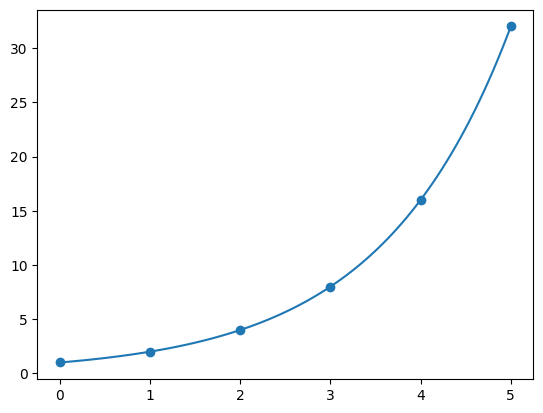Recursion¶
Recursion is one of these topics then when you see it once, you’ll see it again and again forever. Terrible I know…
Seriously it is best described as a function that calls itself. We see these often in simple mathematical questions.
Exponential Growth¶
Consider a population of aemebas that double every cycle. Write a recursive relationship describing this doubling.
We see simply that \(f(n+1) = 2f(n)\) so if you go to the new cycle, \(n+1\), you will be double the previous. The question then arrifes how do we write the function \(f(n)\) where it does not reference itself?
If you recall college algebra, you can write this function as \(f(n) = P_02^n\) Here \(P_0\) is some initial population.
Let’s code both of these by setting \(f(0) = P_0 = 1\) (we always need an initial conditon to fully sovle these equations)
def f_recursive(n):
if n>=1:
return 2*f_recursive(n-1)
elif n==0:
return 1
def f_exponential(n):
return 1*2**n
f_recursive(5)
32
f_exponential(5)
32
We’ll look at the graphs of each.
import matplotlib.pyplot as plt
import numpy as np
x = np.linspace(0,5,100)
y = f_exponential(x)
z = range(0,6)
zz = [f_recursive(i) for i in z]
plt.scatter(z,zz)
plt.plot(x,y)
[<matplotlib.lines.Line2D at 0x7aa73a928b20>]

These look spot on! How would we go about converting something that maybe is not so simple or well known? We guess that the solution is \(f(x) = c a^x\) and plug it in and see if we can solve for \(a\) (\(c\) will just drop out most of the time so I’ll forget about it until I ask for initial conditions)
Divide by \(ca^n\) and get
Something More Exotic¶
What is we had a recurrance relaionship of the form $\( f(n) = -3f(n-1)+4f(n-2) \)\( Beacause there are two prior steps, our initial condition will need two parts. \)\( f(0) = 1\quad\quad f(1) =2 \)$
We can of course define it via python recursively:
def f(n):
if n>1:
return -3*f(n-1)+4*f(n-2)
if n==1:
return 2
if n==0:
return 1
[f(i) for i in range(10)]
[1, 2, -2, 14, -50, 206, -818, 3278, -13106, 52430]
How could we get an analytic solution for this? Let’s guess that the solution is \(f(n) = r^n\). Plugging this into our reccurance relation, we see that, $\( r^n = 3r^{n-1} -4r^{n-2} \)$
With some algebra, we see that $\( 0= r^n+3r^{n-1}-4r^{n-2} = r^{n-2}\left(r^2+3r-4\right) = r^{n-2}(r+4)(r-1) \)$
So we see that either \(r=0\) (trivial solution and doesn’t work with our initial conditions) or \(r=-4\) or \(r=1\).
To finish then, we utilize our initial conditions and recall tha I should have used \(f(n) = c r^n\). We arrive at $\( f(n) = c_1(-4)^n+c_21^n\\ f(0) = c_1+c_2 = 1\\ f(1) = -4c_1 +c_2 = 2 \)$
Solving the above system for \(c_1\) and \(c_2\) we see that \(c_1 = -\frac15\) and \(c_2 = \frac65\).
Putting it all together
We define this function with python
def f(x):
return -1/5*(-4)**x+6/5
[f(i) for i in range(10)]
[1.0, 2.0, -2.0, 14.0, -50.0, 206.0, -818.0, 3278.0, -13106.0, 52430.0]
Repeated Roots¶
If you happen to get a repeated root, you can still use this method except that the solution will be of the form, $\( f(n) = c_1r^n+c_2nr^n \)\( The extra \)n$ in the second term will account for the repeated root. Let’s see this in play with an example:
Example¶
Solve $\( f(n) = 4f(n-1)-4f(n-2) \quad\quad f(0) =f(1) = 1 \)$
We rewrite into the form as discussed above: $\( r^n = 4r^{n-1}-4r^{n-2} \)\( Apply a little agebraic magic to get \)\( r^n-4r^{n-1}+4r^{n-2} = r^{n-2}(r^2-4r+4) = r^{n-2}(r-2)^2 \)\( So \)r=2$ is a solution and repeated!
Using the form discussed above, we see that $\( f(n) = c_12^n+c_2n2^n \)\( We apply the initial conditions to solve for \)c_1\( and \)c_2\(. \)\(f(0) = 1 = c_1\)\( \)\(f(1) = 1 = 2c_1+2c_2\)\( So \)c_1 = 1\( and \)c_2 = -\frac12\(. Making \)\( f(n) = 2^n-\frac{n}2 2^n \)$ Let’s test these solutions.
def f(n):
if n==0:
return 1
elif n==1:
return 1
else:
return 4*f(n-1)-4*f(n-2)
[f(i) for i in range(10)]
[1, 1, 0, -4, -16, -48, -128, -320, -768, -1792]
def f(x):
return 2**x-x/2*2**x
[f(i) for i in range(10)]
[1.0, 1.0, 0.0, -4.0, -16.0, -48.0, -128.0, -320.0, -768.0, -1792.0]
Non-Homogeneous¶
Thus fas all of the recursive functions we have dealt with had only factors invloving the function before. Often this will not be the case. When we have a term that is not recursively defined, we will attempt to use a function that is of the same form as our term. We will have to use some undetermined coefficients to fully solve the problem. Let’s see this in action
Example¶
This is the same recurance relation that we examined before. The homogeneous part of the solution will stay the same. $\( f_H(n) = c_1(-4)^n+c_21^n \)\( We make a guess at the particular solution \)\( f_P(n) = a5^n \)\( We see what happens when we plug this into the original equation. \)\( a5^n = -3a5^{n-1}+4a5^{n-2}+5^n \)\( We want to find what \)a\( solves the above equation. Rearranging we see that \)\( 0=(a-1)5^n +3a5^{n-1}-4a5^{n-2} = 5^{n-2}((a-1)5^2 +3a5-4a) = 5^{n-2}\left(25a-25+15a-4a\right) = 5^{n-2}\left(36a-25\right) \)\( So to solve this equation \)a = \frac{25}{36}$.
To get the full solution, we combine the homogeneous and particular solution $\( f(n) = f_H(n) +f_P(n) = c_1(-4)^n+c_2+\frac{25}{36} 5^n \)\( We now solve for the initial conditions. \)\( f(0) = 1 = c_1+c_2+\frac{25}{36} \)\( and \)\( f(1) = 2 = -4c_1+c_2+\frac{125}{36} \)$
After some work, I arrive at \(c_1 = \frac{16}{45}\) and \(c_2 = -\frac1{20}\)
So the full solution is $\( f(n) = \frac{16}{45}(-4)^n-\frac1{20}+\frac{25}{36}5^n \)$
Forms for the Non Homogeneous Part¶
Equation |
Form of the Non-Homogeneous Part with undetermined coefficients |
|---|---|
Polynomial |
\(f_P = an^x+bn^{x-1}+cn^{x-2}+\cdots gn+f\) |
Exponential with base \(a\) |
\(f_P = ca^n\) |
Sine and Cosine |
\(f_P = a\sin n+ b\cos n\) |
##References
Discrete Math https://discrete.openmathbooks.org/dmoi3/dmoi.html by Oscar Levin
Python Programming and Numerical Methods https://pythonnumericalmethods.berkeley.edu/notebooks/Index.html
